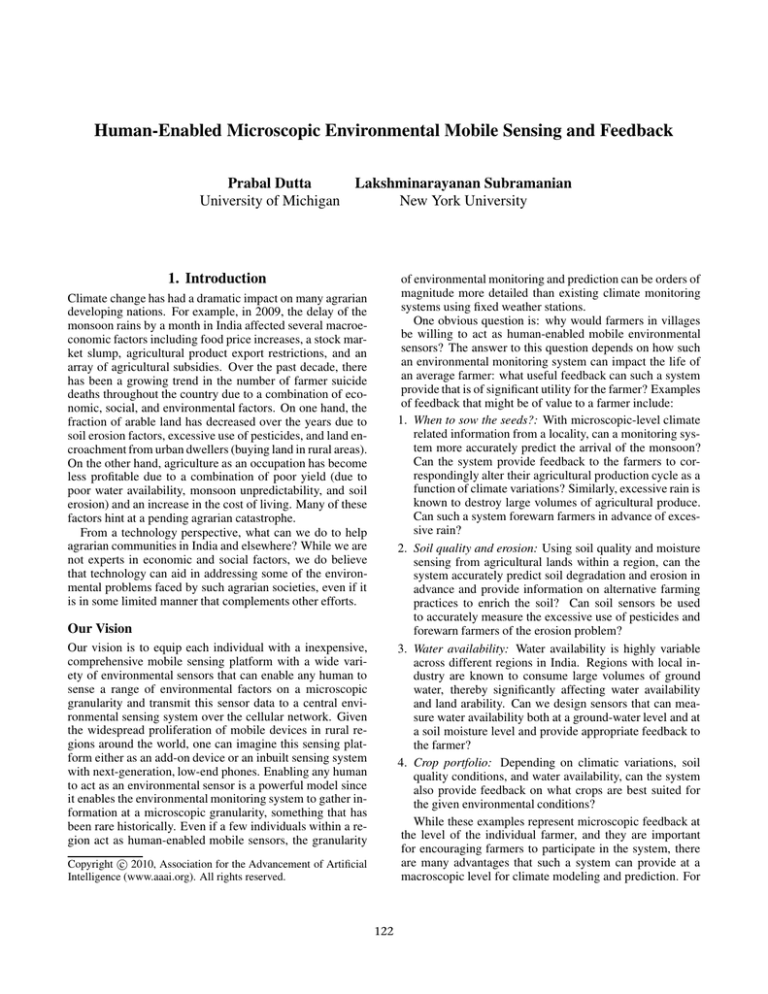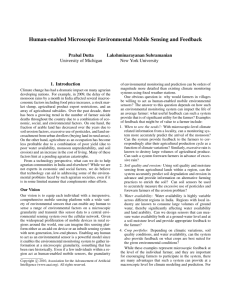
Human-Enabled Microscopic Environmental Mobile Sensing and Feedback
Prabal Dutta
Lakshminarayanan Subramanian
University of Michigan
New York University
1. Introduction
of environmental monitoring and prediction can be orders of
magnitude more detailed than existing climate monitoring
systems using fixed weather stations.
One obvious question is: why would farmers in villages
be willing to act as human-enabled mobile environmental
sensors? The answer to this question depends on how such
an environmental monitoring system can impact the life of
an average farmer: what useful feedback can such a system
provide that is of significant utility for the farmer? Examples
of feedback that might be of value to a farmer include:
1. When to sow the seeds?: With microscopic-level climate
related information from a locality, can a monitoring system more accurately predict the arrival of the monsoon?
Can the system provide feedback to the farmers to correspondingly alter their agricultural production cycle as a
function of climate variations? Similarly, excessive rain is
known to destroy large volumes of agricultural produce.
Can such a system forewarn farmers in advance of excessive rain?
2. Soil quality and erosion: Using soil quality and moisture
sensing from agricultural lands within a region, can the
system accurately predict soil degradation and erosion in
advance and provide information on alternative farming
practices to enrich the soil? Can soil sensors be used
to accurately measure the excessive use of pesticides and
forewarn farmers of the erosion problem?
3. Water availability: Water availability is highly variable
across different regions in India. Regions with local industry are known to consume large volumes of ground
water, thereby significantly affecting water availability
and land arability. Can we design sensors that can measure water availability both at a ground-water level and at
a soil moisture level and provide appropriate feedback to
the farmer?
4. Crop portfolio: Depending on climatic variations, soil
quality conditions, and water availability, can the system
also provide feedback on what crops are best suited for
the given environmental conditions?
While these examples represent microscopic feedback at
the level of the individual farmer, and they are important
for encouraging farmers to participate in the system, there
are many advantages that such a system can provide at a
macroscopic level for climate modeling and prediction. For
Climate change has had a dramatic impact on many agrarian
developing nations. For example, in 2009, the delay of the
monsoon rains by a month in India affected several macroeconomic factors including food price increases, a stock market slump, agricultural product export restrictions, and an
array of agricultural subsidies. Over the past decade, there
has been a growing trend in the number of farmer suicide
deaths throughout the country due to a combination of economic, social, and environmental factors. On one hand, the
fraction of arable land has decreased over the years due to
soil erosion factors, excessive use of pesticides, and land encroachment from urban dwellers (buying land in rural areas).
On the other hand, agriculture as an occupation has become
less profitable due to a combination of poor yield (due to
poor water availability, monsoon unpredictability, and soil
erosion) and an increase in the cost of living. Many of these
factors hint at a pending agrarian catastrophe.
From a technology perspective, what can we do to help
agrarian communities in India and elsewhere? While we are
not experts in economic and social factors, we do believe
that technology can aid in addressing some of the environmental problems faced by such agrarian societies, even if it
is in some limited manner that complements other efforts.
Our Vision
Our vision is to equip each individual with a inexpensive,
comprehensive mobile sensing platform with a wide variety of environmental sensors that can enable any human to
sense a range of environmental factors on a microscopic
granularity and transmit this sensor data to a central environmental sensing system over the cellular network. Given
the widespread proliferation of mobile devices in rural regions around the world, one can imagine this sensing platform either as an add-on device or an inbuilt sensing system
with next-generation, low-end phones. Enabling any human
to act as an environmental sensor is a powerful model since
it enables the environmental monitoring system to gather information at a microscopic granularity, something that has
been rare historically. Even if a few individuals within a region act as human-enabled mobile sensors, the granularity
c 2010, Association for the Advancement of Artificial
Copyright Intelligence (www.aaai.org). All rights reserved.
122
information. We envision using the ELMR system as a base
platform for building our mobile sensing applications.
example, in an urban setting, mobile sensing systems can aid
in pollution monitoring and detecting pollution “hotspots.”
To enable both microscopic and macroscopic sensing,
modeling, and feedback, we envision the mobile system supporting a wide range of inexpensive sensors including temperature, humidity, soil quality, soil moisture, air quality
(specially for greenhouse and poisonous gases), chemicals,
water quality, and ground water level. In addition, each device would use GPS to space-time stamp the readings.
The notion of using humans as mobile sensing vehicles
has been explored previously and is the basis of many ongoing urban sensing efforts. N-Smarts (Honicky et al. 2008)
and several other Mobiscopes (Abdelzaher et al. 2007) have
roots in the citizen science movement (Irwin 1995). Some
of these projects focus on air quality measurements but our
approach differs from these prior mobile sensing efforts in
both focus and application. Our goal is to use human-based
mobile sensing in developing regions to study macroscopic
(e.g. climate change, climate variations, ground water availability, and pollution) and microscopic properties (e.g. soil
quality, soil variations, and groundwater levels), as well as
provide appropriate and useful feedback to participants in
order to encourage continued, sustainable participation.
3. AI Research Challenges
Today, agricultural forecasting in developing regions is
largely built on a top-down model – macroscale climate
measurements are used to predict mesoscale weather effects
– with the attendant lack of granularity and fidelity. In contrast to this approach, we envision crowd-sourcing microclimate, water and soil quality data collection. By leveraging ubiquitous mobile phones with inexpensive sensors and
local soil measurements, we believe this relationship can be
inverted – predicting mesoscale climate effects on agriculture using a network of microscale sensors – employing an
iterative development and deployment model, and with attendant improvements in sensing granularity and fidelity.
Several AI research challenges emerge in this effort. First,
devices may be poorly calibrated and may exhibit high variability in the measurements due to individual bias, aging,
and other factors. In this context, which techniques should
be used to cull the signal of interest from bias, noise, and
interference? Second, can we better predict mesoscale climate, water, and soil patterns from poorly calibrated microscale measurements than we can from macroscale climate measurements? A related challenge is to build online models for weather predictions that combine traditional
macroscale climate measurements with a large volume of
micro and mesoscale human-enabled measurements. Finally, such a system will be successful only if it can provide
actionable information to end-users to motivate large-scale
user participation; determining the nature of feedback and
how to predict it as a function of the data utility are fundamentally challenging AI problems.
2. First Steps in this Direction
Recent efforts provide some promising results in both sensor
platforms and inexpensive data collection from mobile devices. Once data are collected, however, the real challenge
of analyzing, modeling, and making predictions begins.
Microclimate Sensing with Cell Phones. Our recent
work has demonstrated the feasibility of integrating a cell
phone core radio, GPS receiver, Bluetooth, and wireless
sensor interface with light, temperature, humidity, orientation, carbon monoxide, ozone, and nitrous oxide sensors in
a handheld package (Dutta et al. 2009). Going forward,
we believe that such devices can be integrated into mobile
phones and also serve as “data mules” for embedded soil or
fixed weather sensors. But using them as sensor endpoints
raises many new issues. How can the unknown biases introduced by people be masked? Does sheer scale obviate
fine-grained calibration? How can privacy be preserved?
Reducing Operational Costs. The price of connectivity in rural areas for voice, data, and messaging services are
relatively expensive compared with local purchasing power.
When data connectivity is not available in rural areas, SMS
becomes the primary means of data transport. However,
SMS is the least economically viable option using a cost
per bit metric. Unfortunately, most existing mobile applications and services are not designed to optimize operational
communication costs. An unoptimized application can dramatically increase the communication costs. To partially
address this concern, we have built Efficient Lightweight
Mobile Records (ELMR) (Kumar et al. 2009), a system
for supporting SMS-based applications on top of an SMSbased protocol stack optimized for minimizing operational
costs of the application. ELMR supports a semantic compression engine which can significantly reduce the number
of bits used on the SMS channel by applications by developing an app-specific, semantic codebook for representing
References
Abdelzaher, T.; Anokwa, Y.; Boda, P.; Burke, J. J.; Estrin,
D.; Guibas, L.; Kansal, A.; Madden, S.; and Reich, J. 2007.
Mobiscopes for human spaces. IEEE Pervasive Computing
6(2):20–29.
Dutta, P.; Aoki, P. M.; Kumar, N.; Mainwaring, A.; Myers, C.; Willett, W.; and Woodruff, A. 2009. Demo abstract: Common sense - participatory urban sensing using
a network of handheld air quality monitors. In Proceedings
of the Seventh ACM Conference on Embedded Networked
Sensor Systems (SenSys’09).
Honicky, R.; Brewer, E.; Paulos, E.; and White, R. 2008.
N-SMARTS: Networked suite of mobile atmospheric realtime sensors. In Proceedings of the Second ACM SIGCOMM Workshop on Networked Systems for Developing
Regions (NSDR’08).
Irwin, A. 1995. Citizen Science: A Study of People, Expertise and Sustainable Development. Routledge.
Kumar, A.; Purandare, A.; Chen, J.; Meacham, A.; and
Subramanian, L. 2009. Elmr: Lightweight mobile health
records (demo also at mobiheld ’09). In Proceedings of the
35th SIGMOD International Conference on Management
of Data (SIGMOD).
123




